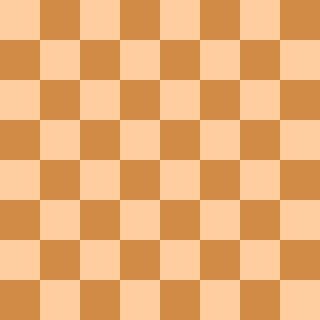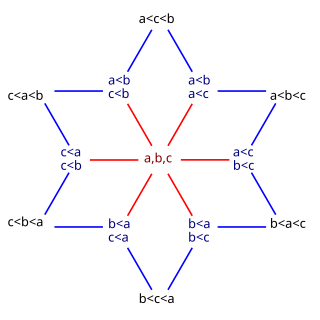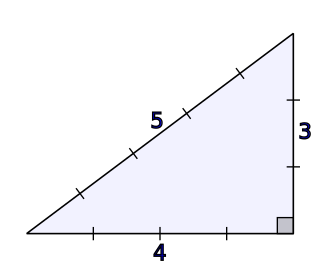
In mathematics and computing, a triangular array of numbers, polynomials, or the like, is a doubly indexed sequence in which each row is only as long as the row's own index. That is, the ith row contains only i elements.

In mathematics and computing, a triangular array of numbers, polynomials, or the like, is a doubly indexed sequence in which each row is only as long as the row's own index. That is, the ith row contains only i elements.
Notable particular examples include these:
Triangular arrays of integers in which each row is symmetric and begins and ends with 1 are sometimes called generalized Pascal triangles; examples include Pascal's triangle, the Narayana numbers, and the triangle of Eulerian numbers. [9]
Triangular arrays may list mathematical values other than numbers; for instance the Bell polynomials form a triangular array in which each array entry is a polynomial. [10]
Arrays in which the length of each row grows as a linear function of the row number (rather than being equal to the row number) have also been considered. [11]
Apart from the representation of triangular matrices, triangular arrays are used in several algorithms. One example is the CYK algorithm for parsing context-free grammars, an example of dynamic programming. [12]
Romberg's method can be used to estimate the value of a definite integral by completing the values in a triangle of numbers. [13]
The Boustrophedon transform uses a triangular array to transform one integer sequence into another. [14]

The eight queens puzzle is the problem of placing eight chess queens on an 8×8 chessboard so that no two queens threaten each other; thus, a solution requires that no two queens share the same row, column, or diagonal. The eight queens puzzle is an example of the more general n queens problem of placing n non-attacking queens on an n×n chessboard, for which solutions exist for all natural numbers n with the exception of n = 2 and n = 3.

In mathematics, a permutation of a set is, loosely speaking, an arrangement of its members into a sequence or linear order, or if the set is already ordered, a rearrangement of its elements. The word "permutation" also refers to the act or process of changing the linear order of an ordered set.

In mathematics, Pascal's triangle is a triangular array of the binomial coefficients. In much of the Western world, it is named after the French mathematician Blaise Pascal, although other mathematicians studied it centuries before him in India, Persia (Iran), China, Germany, and Italy.
In combinatorial mathematics, the Bell numbers count the possible partitions of a set. These numbers have been studied by mathematicians since the 19th century, and their roots go back to medieval Japan. In an example of Stigler's law of eponymy, they are named after Eric Temple Bell, who wrote about them in the 1930s.
Combinatorics is a branch of mathematics concerning the study of finite or countable discrete structures.

In mathematics, a pyramid number, or square pyramidal number, is a figurate number that represents the number of stacked spheres in a pyramid with a square base. Square pyramidal numbers also solve the problem of counting the number of squares in an n × n grid.
In mathematics, a combinatorial class is a countable set of mathematical objects, together with a size function mapping each object to a non-negative integer, such that there are finitely many objects of each size.
Singmaster's conjecture is a conjecture in combinatorial number theory in mathematics, named after the British mathematician David Singmaster who proposed it in 1971. It says that there is a finite upper bound on the multiplicities of entries in Pascal's triangle. It is clear that the only number that appears infinitely many times in Pascal's triangle is 1, because any other number x can appear only within the first x + 1 rows of the triangle.

In number theory and enumerative combinatorics, the ordered Bell numbers or Fubini numbers count the number of weak orderings on a set of n elements. Starting from n = 0, these numbers are

In mathematics, a nonhypotenuse number is a natural number whose square cannot be written as the sum of two nonzero squares. The name stems from the fact that an edge of length equal to a nonhypotenuse number cannot form the hypotenuse of a right angle triangle with integer sides.
In mathematics, a Delannoy number describes the number of paths from the southwest corner of a rectangular grid to the northeast corner, using only single steps north, northeast, or east. The Delannoy numbers are named after French army officer and amateur mathematician Henri Delannoy.
The Hosoya triangle or Hosoya's triangle is a triangular arrangement of numbers based on the Fibonacci numbers. Each number is the sum of the two numbers above in either the left diagonal or the right diagonal. The first few rows are:
1 1 1 2 1 2 3 2 2 3 5 3 4 3 5 8 5 6 6 5 8 13 8 10 9 10 8 13 21 13 16 15 15 16 13 21 34 21 26 24 25 24 26 21 34 55 34 42 39 40 40 39 42 34 55 89 55 68 63 65 64 65 63 68 55 89 144 89 110 102 105 104 104 105 102 110 89 144 etc.
The mathematical field of combinatorics was studied to varying degrees in numerous ancient societies. Its study in Europe dates to the work of Leonardo Fibonacci in the 13th century AD, which introduced Arabian and Indian ideas to the continent. It has continued to be studied in the modern era.

In mathematics, the telephone numbers or the involution numbers are a sequence of integers that count the ways n telephone lines can be connected to each other, where each line can be connected to at most one other line. These numbers also describe the number of matchings of a complete graph on n vertices, the number of permutations on n elements that are involutions, the sum of absolute values of coefficients of the Hermite polynomials, the number of standard Young tableaux with n cells, and the sum of the degrees of the irreducible representations of the symmetric group. Involution numbers were first studied in 1800 by Heinrich August Rothe, who gave a recurrence equation by which they may be calculated, giving the values

In mathematics, the Bell triangle is a triangle of numbers analogous to Pascal's triangle, whose values count partitions of a set in which a given element is the largest singleton. It is named for its close connection to the Bell numbers, which may be found on both sides of the triangle, and which are in turn named after Eric Temple Bell. The Bell triangle has been discovered independently by multiple authors, beginning with Charles Sanders Peirce (1880) and including also Alexander Aitken (1933) and Cohn et al. (1962), and for that reason has also been called Aitken's array or the Peirce triangle.

In mathematics, the (2,1)-Pascal triangle is a triangular array.
Bernoulli's triangle is an array of partial sums of the binomial coefficients. For any non-negative integer n and for any integer k included between 0 and n, the component in row n and column k is given by: